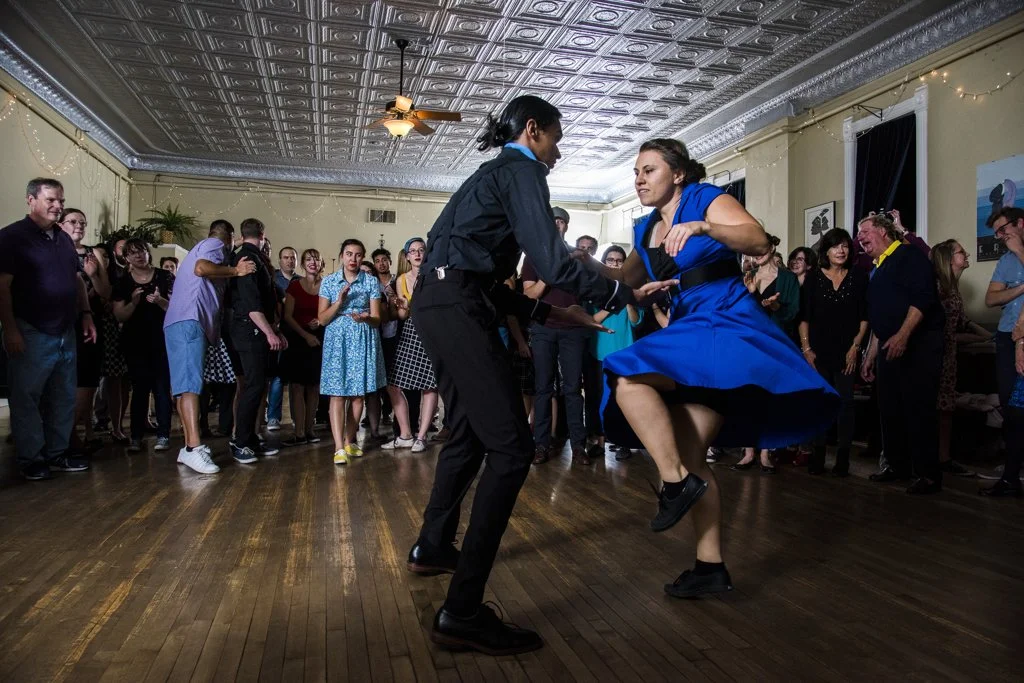Vernacular Partner Dance | Velocity of Celebration
Lindy Hop is a vernacular partner dance created in Harlem ballrooms by the neighboring Black community in the late 1920s. Its development and maturation was influenced greatly by other vernacular dances such as the cakewalk and Charleston. “The term vernacular refers to dance performed to the rhythms of African American music: dance that makes those rhythms visible.” - Steppin’ on the Blues.
"The Lindy Hop also involved a redefinition of gender relations that struck at the core of prevailing derogatory and demeaning racial characterizations of African Americans. Developing into a comprehensive and rhythmically charged critique of the European partner-dancing tradition, it articulated a new aesthetic of cultural equality. Dominated by continuous rhythmic play in its defining swing-outs, the two partners rhythmically improvised while separating apart and drawing back together. The driving reciprocal dynamic of both partners characterized the essential vitality of the dance that paid minimal deference to the ballroom conventions of leaders and followers. Through such mutually assertive roles of independently and jointly sustaining a combined interactive rhythmic response to swing music, the new Lindy Hoppers made a major contribution to transforming the way these dancing African Americans not only saw each other but also how other blacks and whites perceived them. Defining individual expression in the context of working closely with another person (i.e., thus revealing its true jazz character) enabled the Lindy Hop to make such a dramatic impact. Black dancing bodies became 'hep' and respectfully imitated." - Social Dancing at the Savoy
“The smallest pair on the floor on the floor, Mattie Purnell and George Snowden, garnered a $15 gold prize for the fanciest performance of a new dance called the "‘Lindbergh Hop.” The World, June 20, 1928. History is confusing here on how Lindy Hop got its name, but you can read more HERE.
Needless to say, Lindy Hop is embodied joy, improvisational, and rhythmic; danced to swing music of the 1930s and 40s, and modern swing bands embodying this musical style. Watch below!
Videos
(Content Warning: blackface) In After Seben, filmed in 1929, Mattie Purnell and “Shorty” George Snowden are the last couple to perform. You can see them doing a breakaway step, where they separate briefly and come back together. We consider this the foundation for Lindy Hop’s quintessential swingout.
The emcee is a white actor, James Barton, in blackface. It is unfortunately all too common for Black vintage dance clips to either feature white actors in blackface, Black dancers in servant costumes, Black dancers often in high-energy performance movie roles compared to white dancers lower-energy social dancing roles, and these dance scenes features Black dancers being easily removed for Southern audiences.
If Mattie Purnell and George Snowden were first-generation lindy hoppers, then Frankie Manning (Ambassador of Lindy Hop) and Norma Miller (Queen of Swing), dancing below, were second-generation. From Frankie Manning’s auto-biography: “I found that I could still use my feet like Shorty, but move more rhythmically and use my body to express what I was hearing the music, which was changing over from a more up-and-down rhythm of the ‘20s to this real smooth type of swing.”
Here’s a clip of them dancing between 1985-1986 on 125th St. near 5th Ave. Frankie is around 71 here and Norma was around 66. While nearly 40 years after swing’s heyday, you can still get a sense of Lindy Hop’s evolvement as swing music transformed with the driving 4/4 beat.
We’ve seen the foundations of Lindy Hop in 1929 and witnessed the change as older second-generation Lindy Hoppers social danced in their later years. Now, let’s enjoy the Lindy Hop scene in Hellzapoppin’ (1941) while we watch in the greater context of its times and to enjoy the amazing dancers.
Thanks to a confluence of many different factors, Lindy Hop can be found worldwide now and it’s quite popular in Colorado especially along the Front Range communities. Catch a glimpse below when the community came together in a fun project along Boulder’s Pearl Street Mall to Jeremy Mohney.
We’re going to further contrast Hellzapoppin’ with Hot Chocolate, a soundie featuring Duke Ellington’s Cottontail, also from 1941. Whitey’s Lindy Hoppers also utilized the same choreography as Hellzapoppin’ but changed the ending. In order of appearance: William Downes and Frances "Mickey" Jones, Norma Miller and Billy Ricker, Al Minns and Willa Mae Ricker, Ann Johnson and Frankie Manning. We delight here in the difference of costumes, though the coats are indicative of it being a cold environment.

